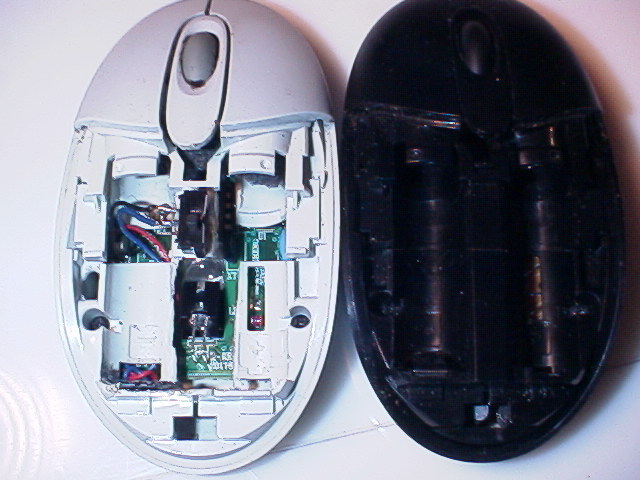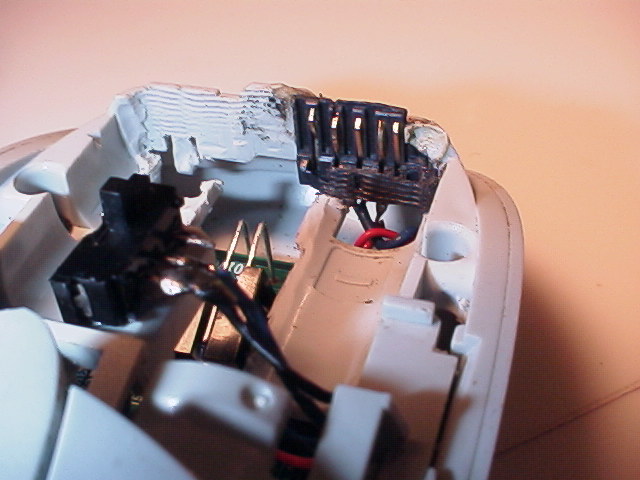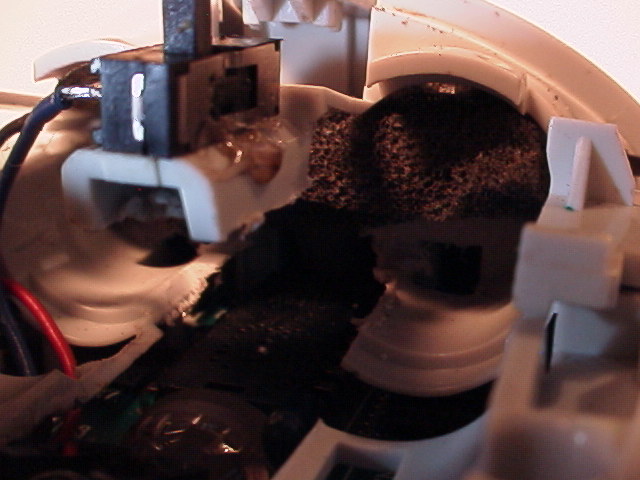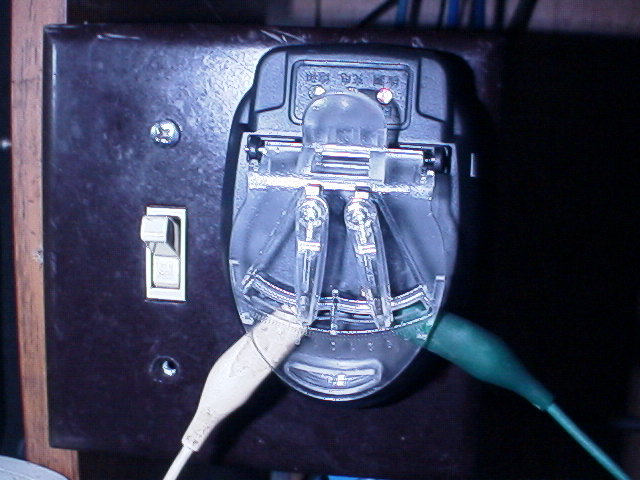MODIFIED MOUSE RUNS ON LITHIUM ION CELL PHONE BATTERY
I
got a couple of Logitech cordless, optical mice for cheap from an eBay auction. They work great, but they are battery hogs. A pair of AA alkalines only lasted a week or two, and when I used rechargeables, they only lasted a couple of days before needing a recharge.
At one point I mused that it would be nice to be able to power the mice with the BL-5C Lithium Ion batteries that power my cell phone. They recharge quickly and hold a lot of current. Only problem is they are 3.7 volt batteries and the mice are designed to run on a couple of AA's in series... 3 volts. I wondered if the extra .7 volt would be a problem. One way to find out. A couple of jumpers later, I had my answer... the mouse seemed quite happy with 3.7 volts.
The hard part was finding a way to stuff the battery inside the mouse. You have to chop a lot of the battery compartment plastic out, remove the springs, and install a connector assembly that will match up with the BL-5C terminals (if you want it to be removable, more on that later).
 |
These
two mice are the same model, just different color. The one on the left has been modified to run on a Nokia BL-5C 3.7 volt lithium ion cell phone battery. I
also installed a small slide switch with which I can turn the mouse off to conserve battery power. |
I
used a Dremel tool to carefully destroy the battery compartment. You
must take great care not to remove plastic which supports the right and left mouse buttons... nor any that affects operation of the mouse wheel. Look
it over real good before you start chopping! |
 |
 |
I
butchered a flash card connector out of some other piece of equipment to get this improvised connector which I hot-glued in. Only
two of the finger spring contacts are actually used, the others I bent slightly so they are flatter and don't protrude. |
The terminals of the battery are somewhat recessed and my spring contacts had a hard time making contact so I built the terminals up with a little solder. My phone didn't care. This
requires hit-and-run soldering. You have to have the iron just the right temperature so you can get the solder on quickly and remove the iron before you melt the battery case. SAFETY
NOTE: Lithium ion batteries are dangerous critters. They don't take kindly to abuse. These batteries have a safety device built into them to prevent overcharging or over-current (short circuited) which ends up disabling the battery, but that's better than the alternative which the industry euphamistically calls "venting with flame". When even the euphamism sounds scarey, you're dealing with some serious doo-doo. Don't do anything to one of these batteries that can pierce it, overheat it, or otherwise tick it off. |
 |
 |
I
put some foam rubber in the front end of the battery compartment to keep the battery in snug contact with the connector. |
I made this modification about a year ago, before I had a simple way to recharge a Lithium Ion battery - if it were not removable from the mouse. I have just been using my cell phone to recharge the battery when it needs it, which is about every two weeks or so. (I never remember to turn the mouse off at night with the switch.) I have several of the phone batteries, so I can just slip a charged battery in and put the depleted battery in the phone for charging in just a few seconds.
I just received this gizmo from Hong Kong. It is a nifty intelligent Lithium Ion battery charger designed to charge cell phone batteries by slipping them under the spring-loaded clear plastic part, bringing the battery contacts against the two adjustable arms. It
is a simple matter to clip on a couple of jumper cables to charge a battery, even if it were still in a mouse. Making
and mounting the battery contact assembly in the mouse was probably the hardest part of the project and the whole mess could be avoided by using one of these chargers, but you couldn't use the mouse while you wait for it to charge. This
charger cost me $1.50 US with free shipping! from an eBay auction and it works like a champ. |
 |
I've been using this set up for over a year now and the over-voltage has produced no adverse effects, so I decided to share it with the world.
updated March 09, 2011
HOME